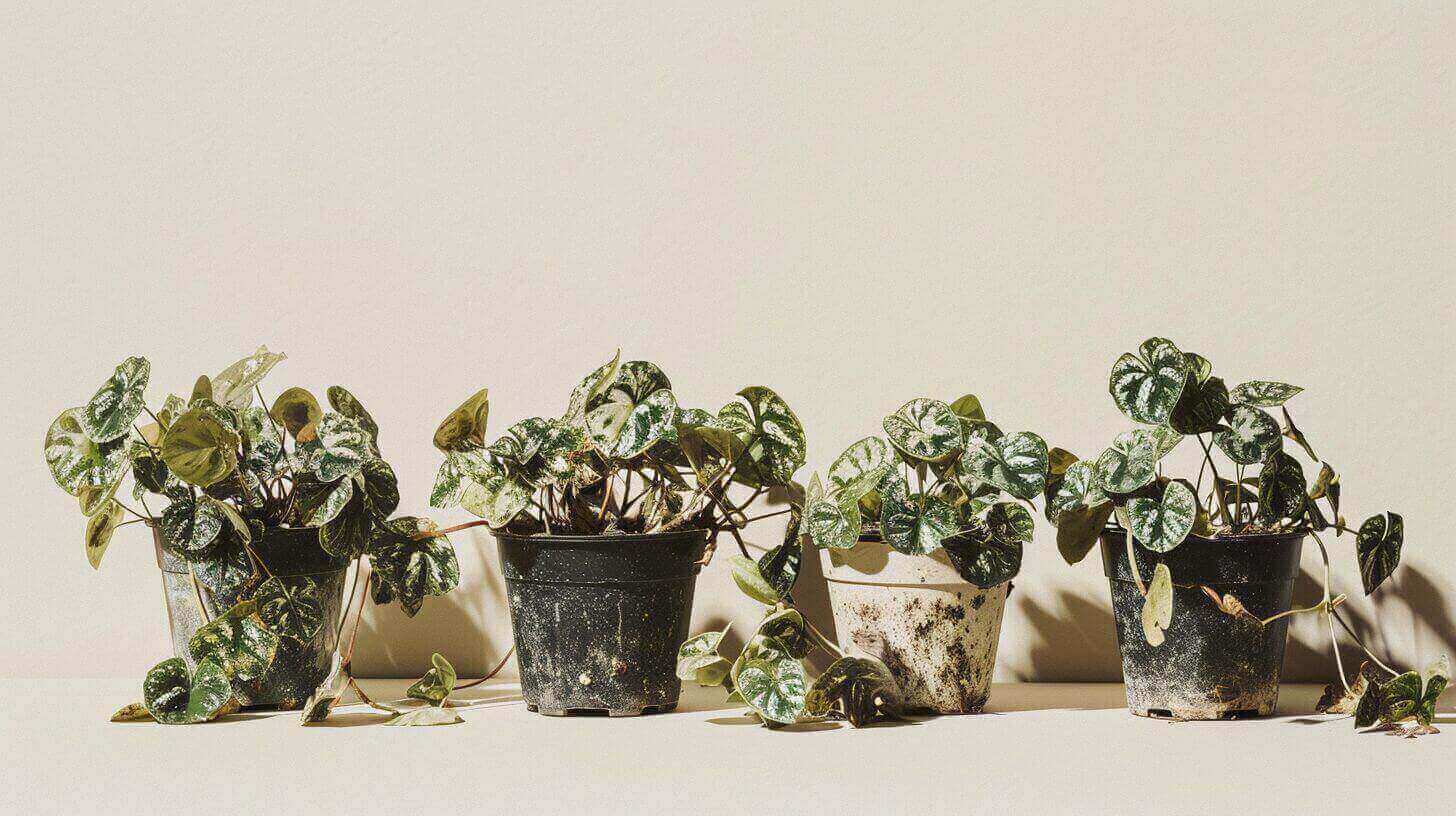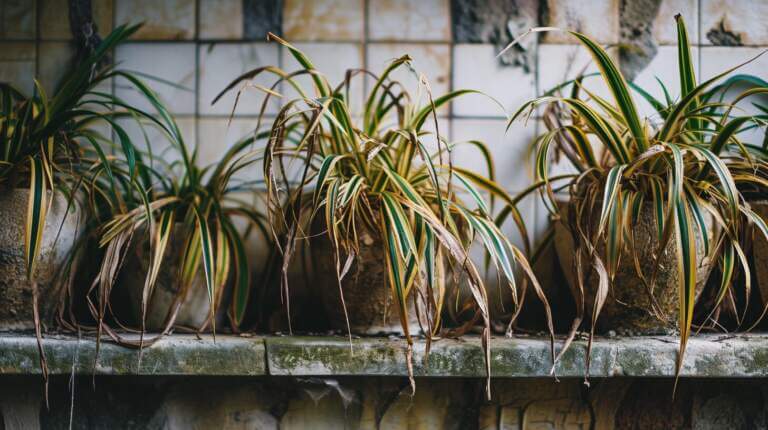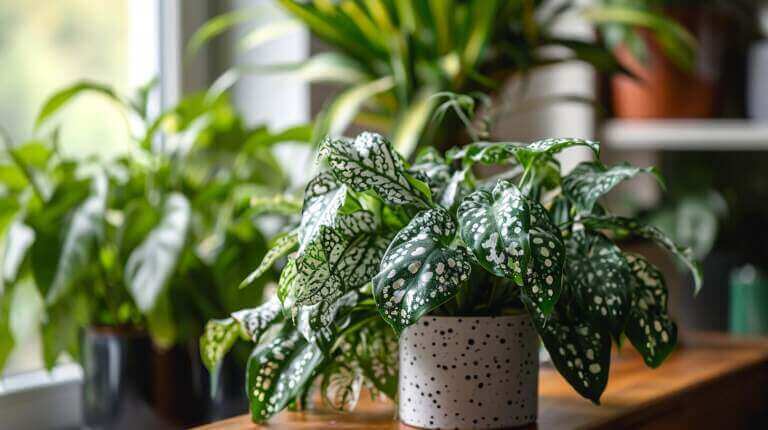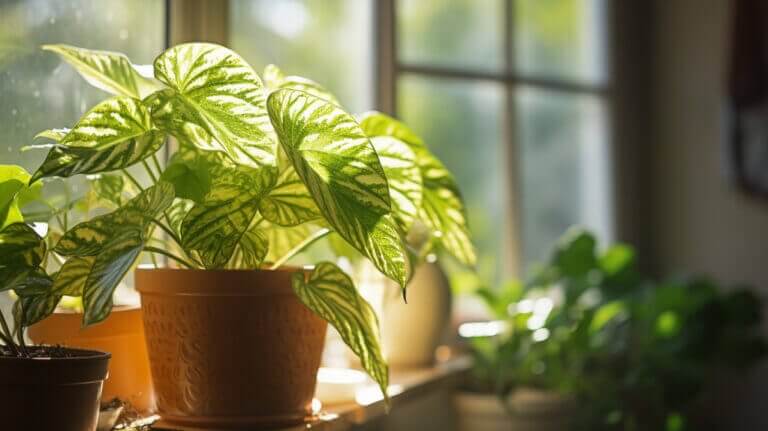Troubleshooting Common Nerve Plant (Fittonia Albivenis) Issues: Crispy Leaves, Drooping, and More
Having trouble with your nerve plant? If you’re experiencing issues like crispy leaves and drooping, don’t worry, I’ve got you covered. Nerve plants, also known as Fittonia, can be temperamental, but with a little troubleshooting, you can get your plant back on track to vibrant health.
When it comes to nerve plants, understanding the common problems and their causes is key. Let’s dive into some solutions for crispy leaves, drooping, and more.
Key Takeaways:
- Common issues with nerve plants include crispy leaves and drooping.
- Proper watering, humidity, and lighting are essential for nerve plant health.
- Water your nerve plant when the top 1-2 inches of soil have dried out.
- Increase humidity by misting the leaves or using a pebble tray.
- Place your nerve plant in bright, indirect light to prevent leaf burn.
How to Properly Water a Nerve Plant
Proper watering is essential for the health of a Fittonia indoor plant. Overwatering or underwatering can lead to crispy leaves and drooping. To ensure that your nerve plant receives the right amount of water, follow these guidelines:
1. Check the Soil Moisture
Before watering your nerve plant, check the moisture level of the soil. The top 1-2 inches should be allowed to dry out before watering again. Insert your finger into the soil, and if it feels dry, it’s time to water.
2. Water Thoroughly
When watering your nerve plant, make sure to thoroughly soak the soil. This helps ensure that water reaches the plant’s roots. Water until you see it draining out of the pot’s drainage holes. This indicates that the soil is adequately saturated.
3. Maintain a Consistent Schedule
Establishing a regular watering schedule is important for the overall health of your nerve plant. Aim to water your plant once the top layer of soil has dried out, but before it becomes completely dry. This helps prevent both overwatering and underwatering.
By following these watering tips, you can help your nerve plant thrive and avoid common issues like crispy leaves and drooping.
| Signs of Overwatering | Signs of Underwatering |
|---|---|
| Mold or fungus growth | Wilting leaves |
| Yellowing of leaves | Brittle or dry leaves |
| Rotten or mushy roots | Leaf drop |
| Stunted growth | Slow or no growth |
Increasing Humidity for a Healthy Fittonia Plant
Nerve plants, also known as Fittonia, thrive in environments with high humidity. If the humidity in your home is too low, it can lead to issues such as crispy leaves and wilting. Fortunately, there are several ways to increase humidity for your nerve plant and create an optimal growing environment.
One simple method to boost humidity is by misting the leaves of your nerve plant. Fill a spray bottle with filtered or distilled water and mist the leaves regularly. This will help create a moist microclimate around the plant and provide the humidity it needs to thrive.
Another option is to use a pebble tray. Fill a shallow tray with water and place pebbles or stones in it. Then, place your nerve plant on top of the pebbles, making sure the bottom of the pot is elevated and not sitting in the water. As the water evaporates, it will increase the humidity around the plant.
If you have a bathroom with higher humidity, consider placing your nerve plant in there. The steam from showers and baths can help create a humid environment that is beneficial for the plant’s growth. Additionally, placing a small humidifier near your nerve plant can also help increase humidity levels.
By providing adequate humidity for your nerve plant, you can prevent issues such as crispy leaves and promote healthy growth. Incorporate these methods into your plant care routine to create an optimal environment and ensure the well-being of your nerve plant.
| Method | Description |
|---|---|
| Misting | Regularly mist the leaves of the nerve plant with filtered or distilled water to create a humid microclimate. |
| Pebble Tray | Place the nerve plant on a tray filled with water and pebbles, allowing the water to evaporate and increase humidity. |
| Bathroom Placement | Position the nerve plant in a bathroom with higher humidity to take advantage of the steam from showers and baths. |
| Humidifier | Use a small humidifier near the nerve plant to generate additional humidity in the surrounding area. |
Providing Proper Lighting for Indoor Fittonia Albivenis Houseplant
Nerve plants, also known as Fittonia, require the right lighting conditions to thrive. Providing the proper amount and quality of light is crucial for their growth and overall health. Direct sunlight can be harmful to nerve plants, causing their leaves to burn and leading to issues such as yellowing and crispy leaves. On the other hand, insufficient light can result in leggy and weak growth. Let’s explore the ideal lighting requirements for a nerve plant to ensure its well-being.
To meet the nerve plant’s light requirements, it is best to provide bright, indirect light. This means placing your plant in a location that receives filtered or diffused sunlight. A north-facing window is an excellent spot as it offers bright light without direct sun exposure. If your nerve plant is receiving intense sunlight, you can use sheer curtains or move it to a spot with less direct light. Remember that each plant is unique, so you may need to experiment with different locations to find the perfect balance of light for your nerve plant.
It’s important to note that lighting conditions can vary depending on your specific circumstances. Factors such as the season, climate, and the proximity of nearby buildings or trees can affect the intensity of light your nerve plant receives. Regularly monitor your plant’s response to the available light and make adjustments accordingly to ensure optimal conditions.
| Lighting Level | Description |
|---|---|
| Bright, Indirect Light | Place the nerve plant near a north-facing window or in a location with filtered sunlight. |
| Low Light | Avoid placing the nerve plant in dimly lit areas or rooms with minimal natural light. |
| Direct Sunlight | Avoid exposing the nerve plant to direct sunlight as it can cause leaf burn and other issues. |
By providing the proper lighting conditions, you can ensure the healthy growth and vibrant appearance of your nerve plant. Remember to consistently monitor and adjust the lighting as needed to support your plant’s specific needs. With the right amount of bright, indirect light, your nerve plant will flourish and become a beautiful addition to your indoor garden.
Common Pests and Diseases for Nerve Plants
Nerve plants, like any other houseplant, can be vulnerable to pests and diseases. Being aware of the common problems that can affect nerve plants is essential for maintaining their health and preventing any potential damage. Here, I will discuss the most prevalent pests and diseases that nerve plants may encounter, along with some tips on how to manage them.
Pests:
Nerve plants can attract a variety of pests, including mealybugs and scales. These tiny insects can infest the leaves and stems of the plant, causing visible damage and affecting its overall growth. Mealybugs appear as white, cottony masses, while scales appear as small, raised bumps that can range in color from brown to black.
To control these pests, you can try using a solution of water and mild dish soap to gently wipe down the affected areas. Alternatively, you can use commercial insecticidal soap or neem oil, following the instructions on the package. Regularly inspecting your nerve plant and promptly addressing any pest infestations can help keep these nuisances at bay.
Diseases:
Nerve plants can also be susceptible to diseases, such as root rot and powdery mildew. Root rot occurs when the plant’s roots are consistently overwatered, leading to fungal growth and decay. Powdery mildew, on the other hand, is a fungal infection that presents as a white, powdery growth on the leaves.
To prevent root rot, ensure that you are not overwatering your nerve plant and that it is planted in well-draining soil. If you suspect root rot, gently remove the plant from its pot and inspect the roots for any signs of rotting. Trim away any affected roots and repot the plant in fresh, well-draining soil.
To manage powdery mildew, improve air circulation around the plant by ensuring it is not crowded by other plants. If the infection is severe, you may need to use a fungicidal spray specifically formulated for powdery mildew. Again, following the instructions on the package is crucial to effectively treat the infection without causing harm to the plant.
| Pest/Disease | Symptoms | Treatment |
|---|---|---|
| Mealybugs | White, cottony masses on leaves and stems | Wipe affected areas with water and mild dish soap or use insecticidal soap/neem oil |
| Scales | Small, raised bumps on leaves and stems | Wipe affected areas with water and mild dish soap or use insecticidal soap/neem oil |
| Root Rot | Foul odor, wilting, yellowing leaves | Trim affected roots, repot in fresh soil, adjust watering practices |
| Powdery Mildew | White, powdery growth on leaves | Improve air circulation, use fungicidal spray if necessary |
Propagating and Repotting Nerve Plants
Propagating a nerve plant is a great way to create new plants and expand your collection. To propagate a nerve plant, you can take stem cuttings. Ideally, this should be done in the spring or early summer when the plant is actively growing. Simply cut a healthy stem just below a leaf node and place it in a container with well-draining soil. Keep the soil consistently moist and in a warm location, and soon you’ll see roots forming.
Another method of propagation is through division. Every few years, you can divide your mature nerve plant to refresh the soil and promote healthy growth. Gently remove the plant from its pot and carefully separate the roots into smaller sections. Plant each section in its own pot with fresh soil, making sure to water thoroughly. This will give each new plant the space it needs to thrive.
When it comes to repotting your nerve plant, it’s important to choose the right pot and soil. Select a pot that is slightly larger than the current one, with drainage holes to prevent waterlogging. Use a well-draining soil that retains some moisture, but not too much. This will help prevent overwatering and root rot. Gently remove the plant from its current pot, loosen the roots, and place it in the new pot. Fill in around the roots with fresh soil and water thoroughly. Repotting every 1-2 years will provide your nerve plant with the nutrients and space it needs to continue thriving.
FAQ
Why are the leaves of my nerve plant crispy?
Crispy leaves in a nerve plant can be caused by overwatering or underwatering. Make sure to allow the top 1-2 inches of soil to dry out before watering and ensure thorough watering when you do water.
Why is my nerve plant drooping?
Drooping in a nerve plant can be a sign of watering issues, humidity problems, or inadequate lighting. Check that you are properly watering, increase humidity if necessary, and provide the plant with bright, indirect light.
How can I increase humidity for my nerve plant?
To increase humidity, mist the leaves with filtered or distilled water or use a pebble tray filled with water. You can also place your nerve plant in a bathroom or near a humidifier to provide adequate humidity.
What kind of lighting does a nerve plant need?
Nerve plants prefer bright, indirect light. Direct sunlight can cause the leaves to burn. Place your nerve plant near a north-facing window or use sheer curtains to filter intense sunlight.







